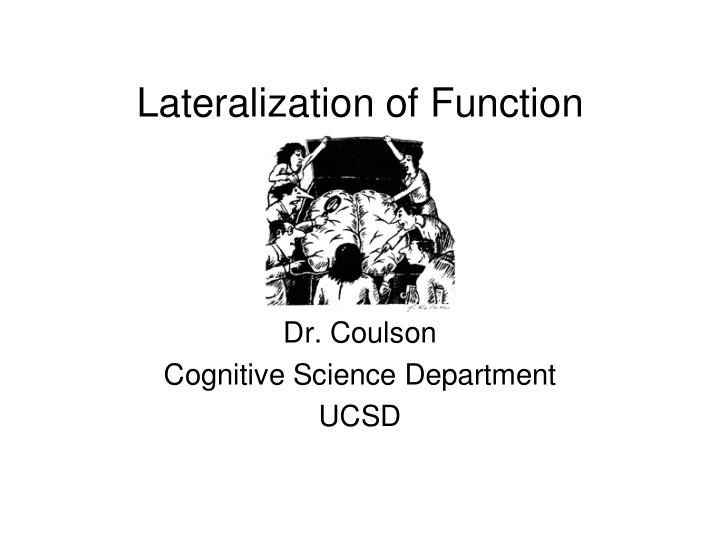



Lateralization of Function Dr. Coulson Cognitive Science Department UCSD
Human Brain • An extension of the spinal cord
Cerebral Hemispheres
Corpus Callosum
Cartoon View of Brain
Cerebral Lobes
Neurons • Brain composed of neurons – 100 billion • Neurons both send and receive signals to other receive signals to other cells in form of pulses • Important parts – Cell body – Axon – Synapse
Connectivity • Each neuron connected to 10,000 other neurons • Point of contact is the • Point of contact is the synapse • Computing power of brain comes from connections
Cortex • Two millimeters thick and has area of 1.5 square meters
Cartoon View: Frontal Lobe • In front of central sulcus • Decisions, judgments, emotions emotions
Cartoon View: Parietal Lobe • Behind central sulcus • Perception of stimuli related to touch, pressure, pressure, temperature, pain
Cartoon View: Temporal Lobe • Below lateral fissure • Perception, recognition, auditory processing processing
Cartoon View: Occipital Lobe • Located at back of brain, behind the parietal lobe and temporal lobe • Vision
Lateralization of Function • One side of the brain is more crucial for a given function and/or more efficient at the underlying computational tasks • Typically a matter of • Typically a matter of degree – Strongly vs. Weakly Lateralized • Motor control a good example of a lateralized function
Sensorimotor Cortex
Motor Control
What about language? • Language is a paradigmatic example of a lateralized cognitive phenomenon
Wada Test
Lateralization of Function • Most evidence of lateralized brain function comes from observing how brain damage affects behavior on various sorts of cognitive tasks
Paul Broca • 19 th century French neurologist • Star patient: Leborgne • Understood most of what was said to him • Able to eat, drink (move mouth and tongue) • Only utterance was “tan”
Broca’s Discovery • Leborgne’s brain had damage to the lower rear portion of frontal lobe, lower front portion of parietal lobe, and upper part of the temporal lobe • Broca deemed frontal lobe damage most important damage most important • Aphasia – partial or total loss of ability to articulate ideas due to brain damage • Broca’s Area – lower rear portion of frontal lobe, adjacent to motor cortex – Inferior frontal gyrus – Brodmann’s Areas 44/45
Brodmann’s Areas • Korbinian Brodmann examined brain cells with various stains designed to detect chemical differences between areas • Brain areas defined by cytoarchitectonic characteristics known as Brodmann’s Areas – 52 areas in the human brain (though some subdivided into a, b, – 52 areas in the human brain (though some subdivided into a, b, etc)
Broca’s Aphasia • M.E. Cinderella...poor...um 'dopted her...scrubbed floor, um, tidy...poor, um...'dopted...Si-sisters and mother...ball. Ball, prince um, shoe... • Examiner Keep going. • M.E. Scrubbed and uh washed and un...tidy, uh, sisters and mother, prince, no, prince, yes. Cinderella hooked prince. (Laughs.) Um, um, shoes, um, twelve o'clock ball, finished. • • Examiner So what happened in the end? Examiner So what happened in the end? • M.E. Married. • Examiner How does he find her? • M.E. Um, Prince, um, happen to, um...Prince, and Cinderalla meet, um met um met. • Examiner What happened at the ball? They didn't get married at the ball. • M.E. No, um, no...I don't know. Shoe, um found shoe...
Wernicke’s Aphasia • 1871 Karl Wernicke reported a different sort of language disorder • Symptoms – Talk fluently, excessively – Use made up words – Don’t understand, in spite of intact hearing
Wernicke’s Area
Wernicke’s Area
Wernicke’s Aphasic • C.B. Uh, well this is the ... the /dodu/ of this. This and this and this and this. These things going in there like that. This is /sen/ things here. This one here, these two things here. And the other one here, back in this one, this one /gesh/ look at this one. • Examiner: Yeah, what's happening there? • C.B. I can't tell you what that is, but I know what it is, but I don't know where it is. But I don't know what's under. I know it's you know where it is. But I don't know what's under. I know it's you couldn't say it's ... I couldn't say what it is. I couldn't say what that is. This shu-- that should be right in here. That's very bad in there. Anyway, this one here, and that, and that's it. This is the getting in here and that's the getting around here, and that, and that's it. This is getting in here and that's the getting around here, this one and one with this one. And this one, and that's it, isn't it? I don't know what else you'd want. • Describing a picture of a child taking a cookie
Pop Quiz
Pop Quiz
Sex Differences • Women more vulnerable to aphasia after damage to frontal lobe • Men more vulnerable to aphasia after damage to aphasia after damage to parietal and temporal lobe areas • Similar sex differences in apraxia , impairment in voluntary motions
Wernicke-Geschwind Model • Broca’s Area stores motor representation of speech • Wernicke’s Area stores auditory representation of auditory representation of speech sounds • Connected by fiber tract known as arcuate fasiculus • Considered an oversimplified model
Wernicke-Geschwind Model: Repeating a Spoken Word
Reading a Written Word
cortex X Concepts Association Cortex X Ventral prefrontal Posterior Temporal Cortex Motor word Auditory word Comprehension Comprehension Comprehension Comprehension Arcuate Arcuate Fasciculus Speech motor output Auditory input Broca’s Aphasia psychology.rutgers.edu/~rypma/
Concepts Association Cortex Ventral prefrontal X X Posterior Temporal cortex Cortex Motor word Auditory word Comprehension Comprehension Comprehension Comprehension Arcuate Arcuate Fasciculus Speech motor output Auditory input Wernicke’s Aphasia psychology.rutgers.edu/~rypma/
Concepts Association Cortex Ventral prefrontal X X Posterior Temporal cortex Cortex Motor word Auditory word Comprehension Comprehension Comprehension Comprehension Arcuate Arcuate Fasciculus Speech motor output Auditory input Conduction Aphasia psychology.rutgers.edu/~rypma/
Reprise • Wada Test • Broca’s Aphasia • Wernicke’s Aphasia • Conduction Aphasia • But remember, these models are cartoons…
Recommend
More recommend